OnePlus 5 vs Apple iPhone 7 Plus
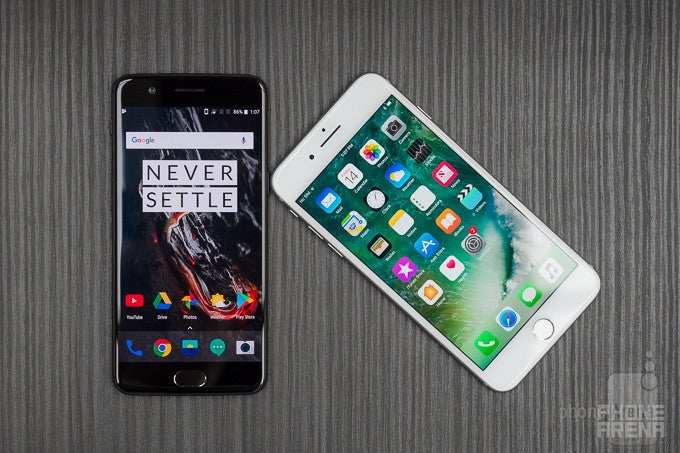
Introduction
OnePlus, a company that started making phones just three years ago, has already built a name for itself with the great value-for-money phones that it makes. The OnePlus 5 is its best and its most expensive phone so far, yet it still costs a lot less than a mainstream flagship like the 5.5-inch Apple iPhone 7 Plus.
The OnePlus 5 looks up to that device (or should we say “copies it”) in a lot of ways: most notably, it has a similar design and it uses a dual camera system with support for Portrait mode, the signature feature of the 7 Plus.
With so many similarities, we just had to directly match up the two in a detailed comparison. We look at the design differences, question ourselves which phone has better performance and battery life, and compare their cameras. Read on.
Design
The OnePlus took a few cues from the iPhone 7 Plus, but its curved back and accents give it its own personality. The iPhone is the original, but it has big bezels and a much biggerfootprint that might be off-putting to some, while the OnePlus is more compact. Unfortunately, there is no water-proofing on the OnePlus.
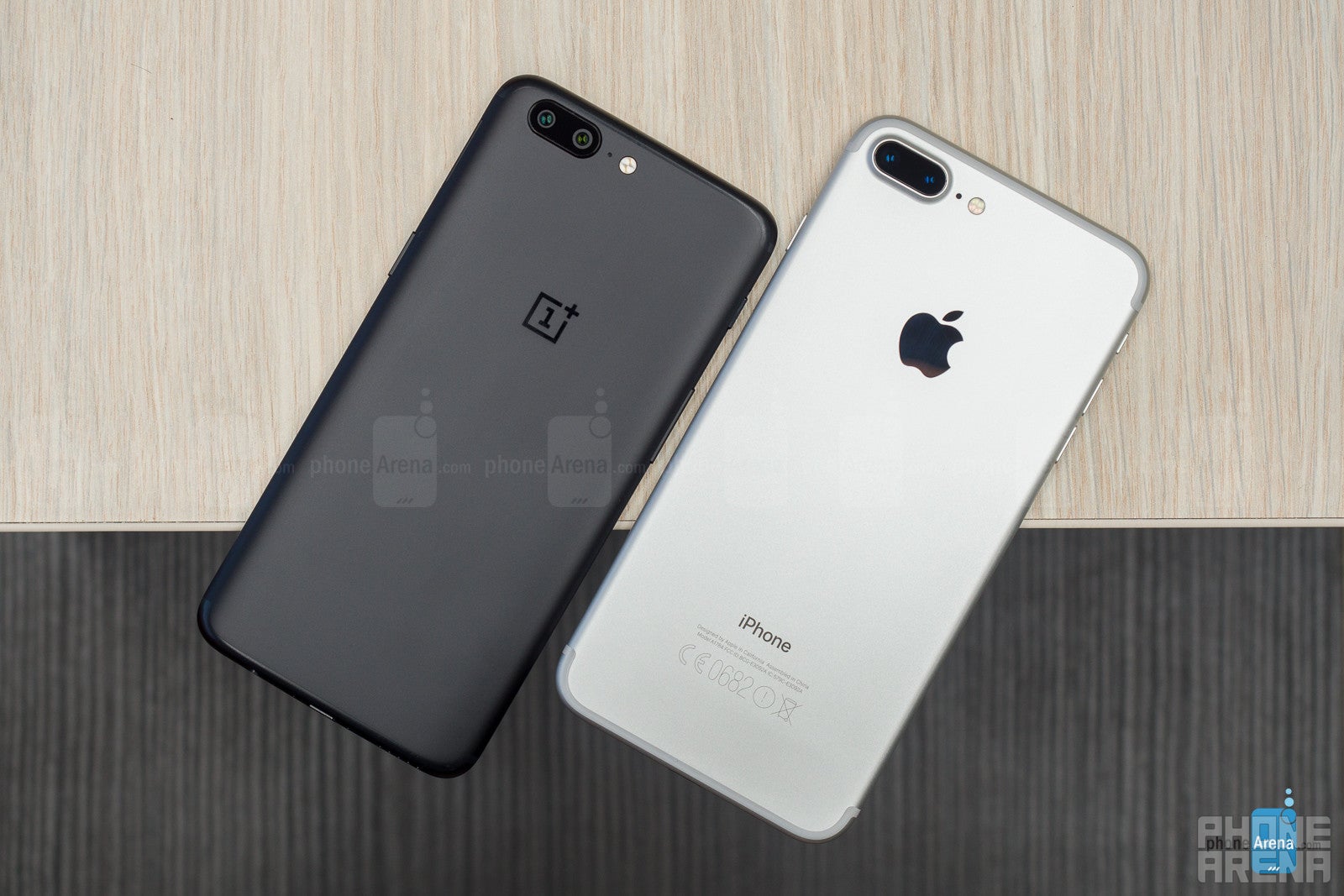
The big surprise with the OnePlus 5 was just how shockingly similar it looked to the iPhone 7 Plus. At least that’s what unofficial leaked pictures of the phone would have had you believe. After you see the phone in real life, you realize that the similarity is there, but it’s not as shocking and in-your-face as those images might have convinced you.
Both the OnePlus 5 and the iPhone 7 Plus are made out of aluminum, with the buttons also made of metal. Buttons feel clicky on both, with a lot of travel, but it takes a little more effort to press a button on the iPhone than on the OnePlus. The OnePlus also features a slight curve on its back, which makes it fit more comfortably in the hand. Both phones are slippery, but the OnePlus more so. We recommend using a case on both for extra protection.
In terms of physical size, the OnePlus 5 has smaller bezels and a narrower footprint, which makes it more ergonomic. The iPhone, on the other hand, is noticeably bigger than the OnePlus and in fact, one of the largest 5.5-inch phones around, which might inconvenience some people.
What the OnePlus 5 still lacks is water-protection. The iPhone 7 Plus is officially IP67 water and dust protected, meaning that it is guaranteed to withstand water damage for as much as 30 minutes under 3 feet deep fresh water. Not having water resistance is not a dealbreaker, but it’s definitely a drawback in our books.
Both phones have their fingerprint scanners conveniently located in the front, right below the display. They are both styled to look like physical keys, but you cannot actually press either. Tapping them brings you to the home screen on both and both feature fingerprint readers that are fast and accurate, but it is the OnePlus 5 that feels faster.
Display
Two gorgeous displays: a 5.5” LCD one on the iPhone, and a 5.5” AMOLED one on the OnePlus.
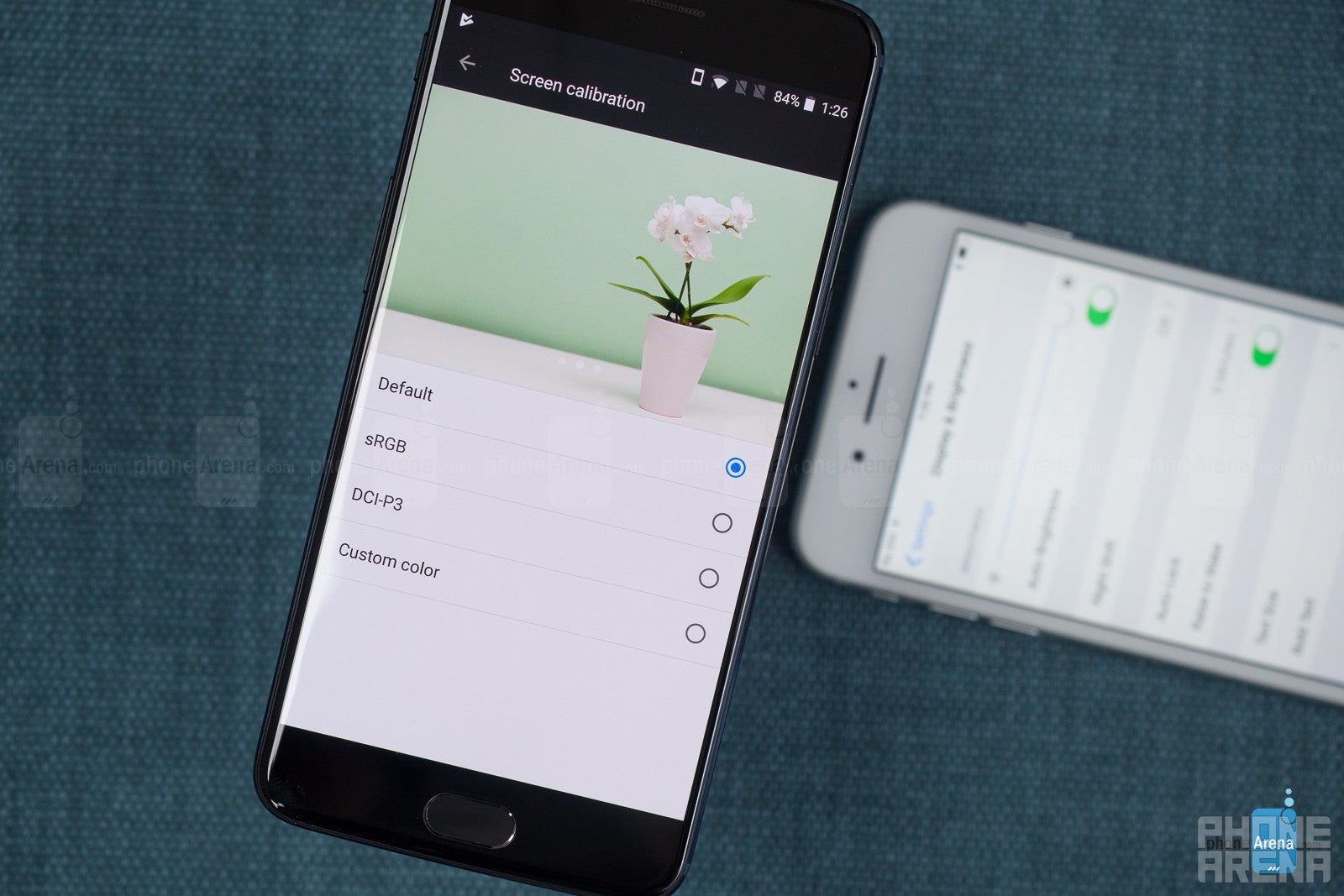
The AMOLED on the OnePlus 5 has a couple of advantages over the LCD one on the iPhone: deeper blacks and better viewing angles being the two major ones, but an LCD screen does not suffer from ghosting artifacts over the years and is usually brighter and easier to see outdoors.
In terms of color reproduction, both phones do a great job. The iPhone 7 Plus is a bit better for one simple reason: Apple’s iOS supports color management and makes full use of the wider DCI-P3 color profile. Put simply, the iPhone knows when a content needs to be shown in wide color and delivers those punchy colors when needed, while Android still lacks system-wide color management. You do get partial color profiles on the OnePlus, though, and colors do look fine on it as well. You can choose between sRGB and DCI-P3 for those punchier colors.
The iPhone also has 3D Touch, a dedicate layer beneath the display that allows it to tell pressure. This comes in handy in most first-party apps and in many third-party ones. It’s particularly useful in the keyboard: 3D Touch it to have it transform into a trackpad that allows very precise positioning of the cursor. The OnePlus lacks such a functionality, instead replacing it partly with the clumsier long press in Android.
Both phones also come with ‘Night’ mode, a built-in blue light filter that helps night birds fall asleep easier and not get distracted by a phone display’s blue light. The effect is customizable on both, but feels a bit more subtle and well made on the iPhone.
The OnePlus also ships with a new ‘Reading’ mode that turns the screen black and white, and makes it sharper. It’s easier on the eyes and emulates an e-book look, and we appreciate having it.
Interface and Functionality
iOS is all about fluidity, quality apps and guaranteed timely updates. OxygenOS on the OnePlus excels in customizations and its clean feel, but will OnePlus support it via updates long enough?
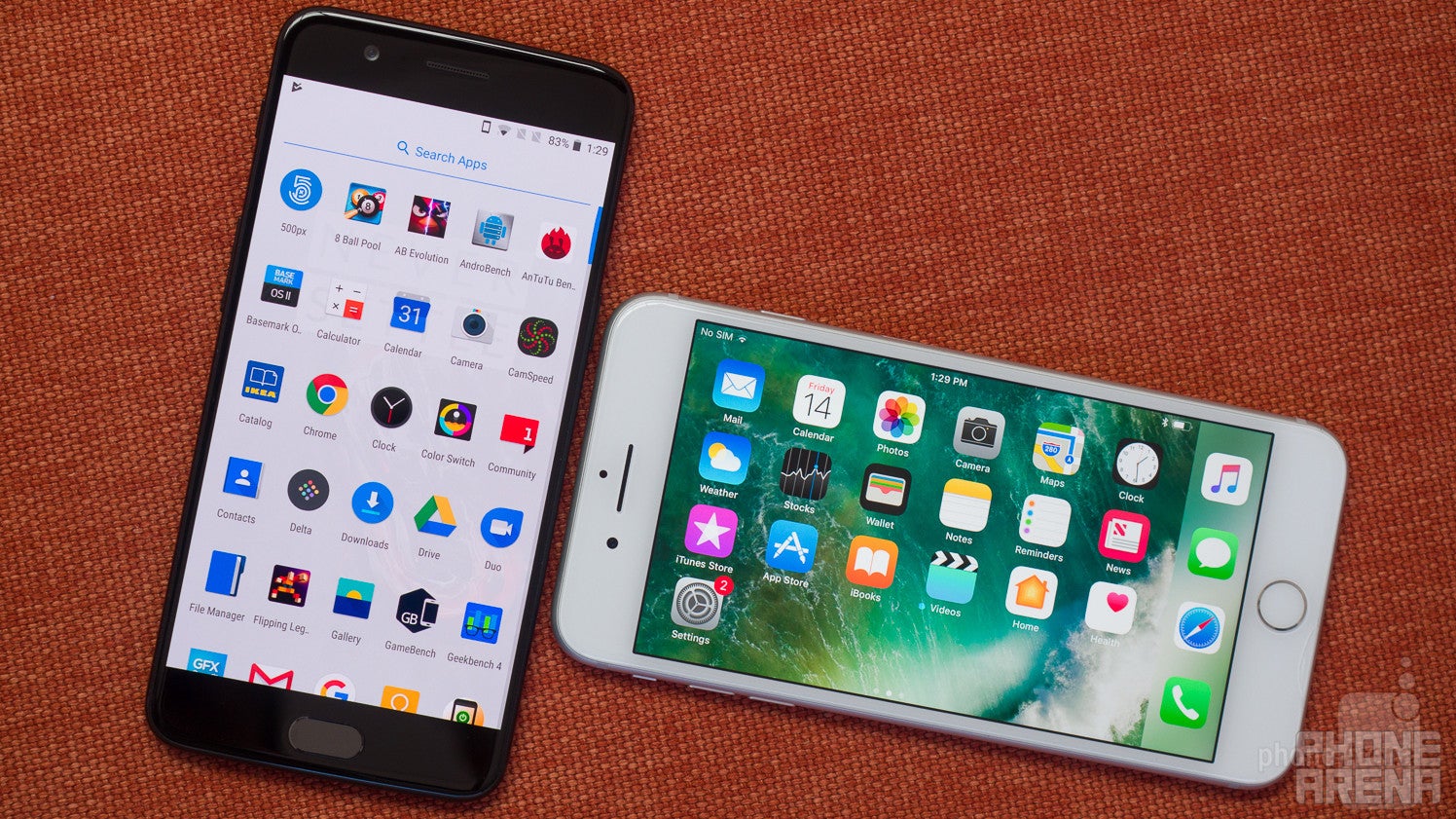
The OnePlus 5 features a clean Android interface that the company calls OxygenOS; the iPhone 7 Plus runs on iOS.
The keywords with the OnePlus are “speed” and “no bloat”, while the keywords about the iPhone is “buttery smooth”. While OxygenOS is an exemplary Android interface with useful customization options and a focus on speed, it lacks the linking chains, the animations and transitions that would make it feel ‘smooth-running’, fluid. The iPhone has got that: nearly perfect fluidity plus the speed.
From there on, it’s a battle of concepts: Android is more open in all aspects and it is more convenient if you have to deal with an avalanche of notifications. The iPhone is more restrictive in its interface looks, but Apple has also done a great job to avoid accidental presses and accidental actions that often happen on Android.
And then there is the software updates situation: software updates on Android are perpetually late a few months (often more) and sometimes never arrive, while iPhone updates are guaranteed to roll out practically on day one and you know that you have a phone that will be secure and up-to-date for years to come.
The notable new features in the OnePlus 5 interface include the swipe-up app drawer, similar to the one on Pixel phones. It’s a much more convenient, coherent way to access your apps. You also have a ‘do not disturb’ mode for gaming where an accidental press of a button will not quit a game, a new ‘secure box’ for your private files, expanded screenshots and auto night mode triggers.
The most discussed issue with the OnePlus 5 is the jelly scrolling effect. Caused by the reversed position of the display, an engineering decision that is said to have something to do with the positioning of the cameras of the phone, OnePlus has not committed to fixing it, so it’s likely to stay. It is noticeable, but I don’t think it’s a dealbreaker or a major concern: you just get used to it after a while.
Processor, Performance and Memory
The Apple A10 chip on the iPhone is even faster than the Snapdragon 835 on the OnePlus 5. Performance is actually fast on both, but smoother and more fluid on the OnePlus.
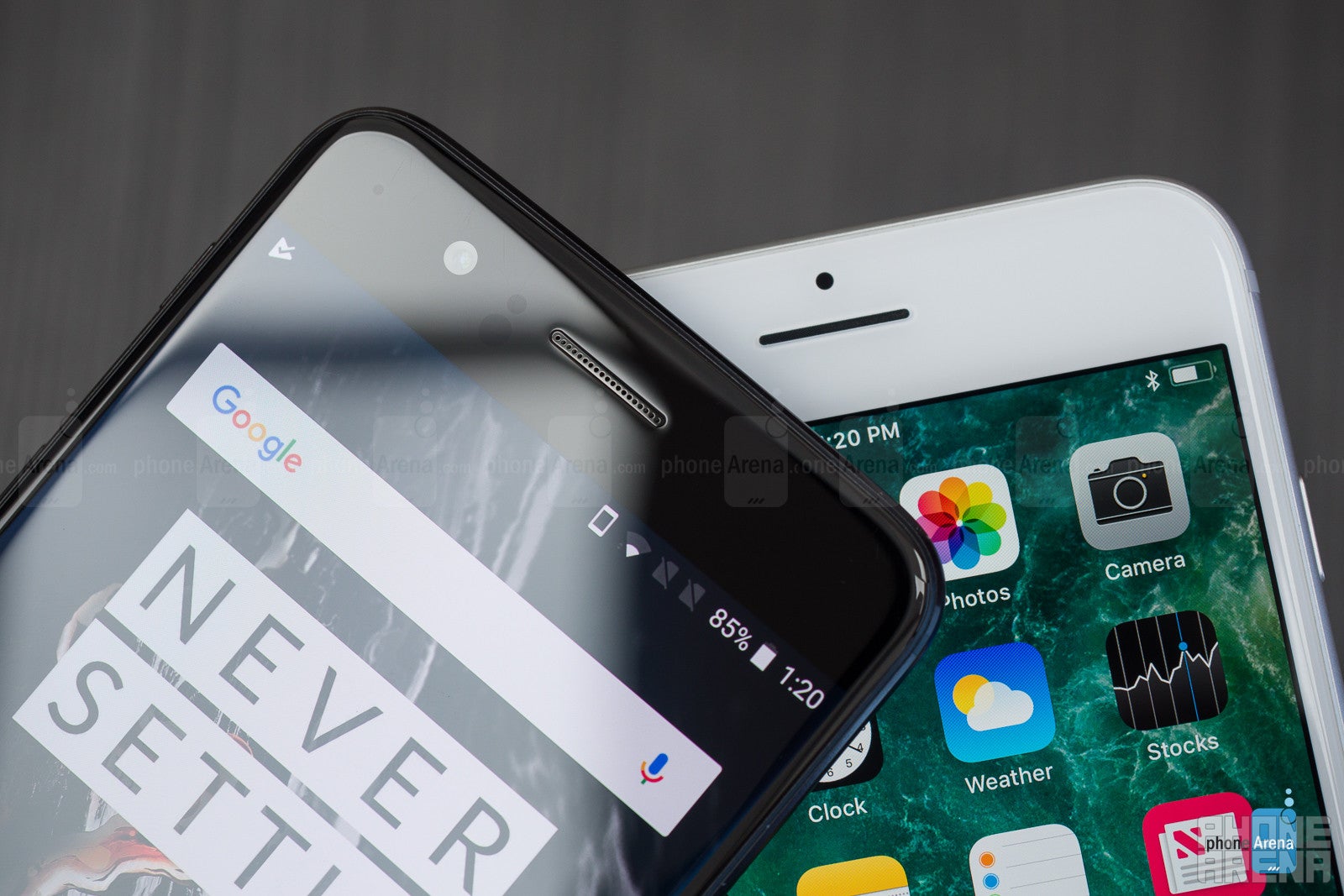
The OnePlus 5 is equipped with the most powerful Android chip out there: the Snapdragon 835, and it’s got a version that comes with 8 gigs of RAM, the most of any phone we have seen so far. But then there is the iPhone: the custom A10 Fusion chip made by Apple is actually more powerful than the Snapdragon 835 in places that matter most like single core performance, and the iOS is optimized to run extremely well even with the 3 GB of RAM that the iPhone 7 Plus has.
So when we talk about performance we look at the overall mixture of software and hardware: not just specs alone that are often misleading if taken out of their context.
Ultimately, we talk about experience more than technicalities and experience is where the iPhone 7 Plus wins. Using the iPhone feels fluid, without interruptions, while using the OnePlus feels fast, but in a stop-and-run, interrupted kind of way rather than a relaxing walk in the park.
For gamers, the iPhone remains the go-to phone and it’s not just its performance. Yes, it does load up games faster and it is better optimized thanks to Apple’s Metal and developers' focused effort on just one device, but it’s also about the fact that the iOS platform gets more and better games earlier and sometimes exclusively.
Next up, we look at the benchmarks that give the hard numbers:
Both the OnePlus 5 and Apple iPhone 7 Plus do not support microSD expandable storage because the companies consider that adding slower cards would cripple the experience. Luckily, both phones are offered in options with plenty of storage: the base OnePlus 5 ships with 64GB of on-board memory and for $40 more you can get the 128 gig model with more RAM. The iPhone starts at 32 gigs, and then you add $100 to the price if you prefer a 128GB model, and $100 more on top if you want a 256GB model. Both feature fast storage that helps with app installs and loading times be faster.
Internet and Connectivity
Both phones come packed with 4G LTE band support. True global phones.
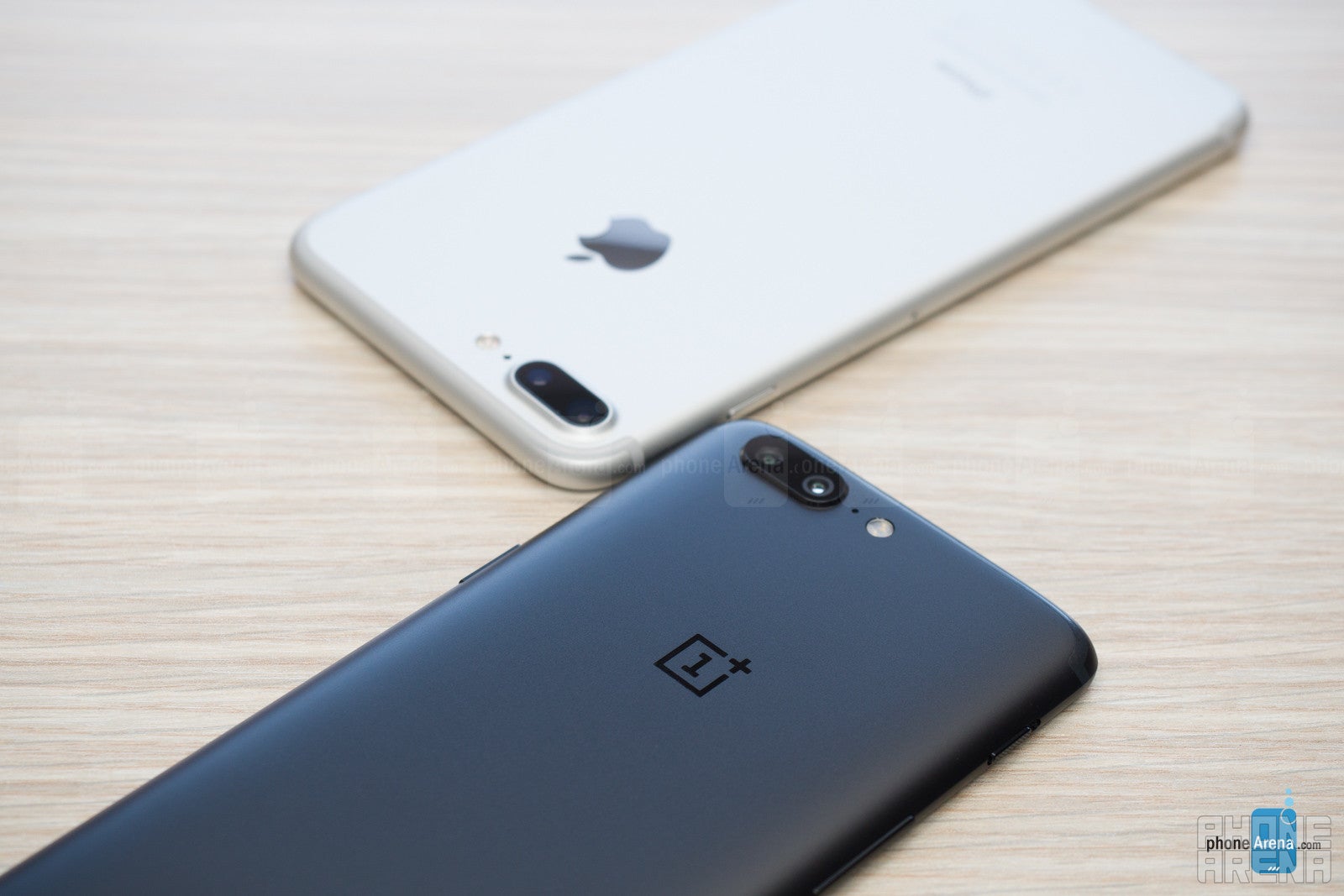
The OnePlus 5 is still not sold by any of the major carriers in the United States: you can only get an unlocked model online. The iPhone 7 Plus? It’s available on all four major U.S. carriers, and it’s offered as an unlocked model.
This has consequences: first and foremost, you cannot use the OnePlus 5 on CDMA carriers like Verizon Wireless and Sprint in the United States. If you are fine with that, you’d be happy to learn that the OnePlus 5 features a ton of 4G LTE bands. In fact, here is a comparison showing the LTE bands supported by these two phones:
OnePlus 5: 1, 2, 3, 4, 5, 7, 8, 12, 17, 18, 19, 20, 25, 26, 28, 29, 30, 66
Apple iPhone 7 Plus: 1, 2, 3, 4, 5, 7, 8, 12, 13, 17, 18, 19, 20, 25, 26, 27, 28, 29, 30
These are definitely two of the phones with support for most LTE bands out there. The difference comes in the iPhone’s support for 4G LTE band 13, a band that is used by Verizon Wireless in the United States. The OnePlus 5, on the other hand features band 66, which is a subset of the AWS bands (used by T-Mobile in the US).
At the end of the day, what all of this tells the average user is that these are true global roamers: you can take them pretty much everywhere across the globe and know that you will get proper connectivity.
Both support dual channel Wi-Fi connections, Bluetooth 5.0 on the OnePlus 5 and Bluetooth 4.2 on the iPhone, and both have NFC on board.
Camera
OnePlus 5 camera has some issues like excessive noise that prevent it from being great, but it’s good nonetheless. The iPhone’s one, however, is better. Portrait mode still feels in beta on both, but OnePlus does suprisingly well.
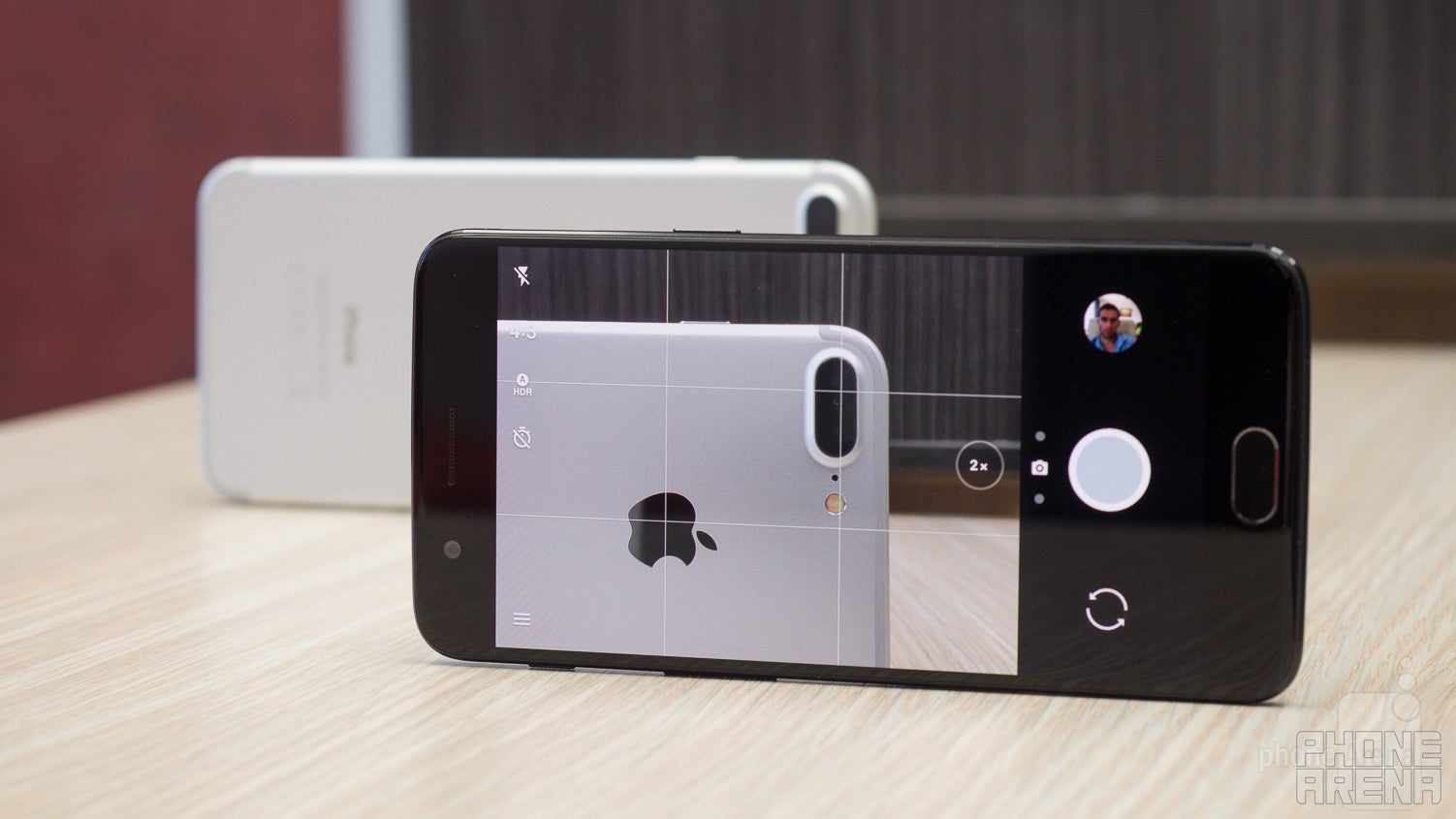
With dual cameras on their backs, both phones come with some photography superpowers.
The OnePlus 5 features a 16-megapixel wide-angle rear camera and a 20-megapixel, ‘telephoto’ one. The use of the term telephoto is usually reserved to a camera that has long focal length, but this is not the case on the OnePlus 5: its main camera has a very wide, 24mm focal length, while the secondary one only has 36mm, which is still wide in our books and nowhere near ‘telephoto’.
The iPhone 7 Plus on the other hand has a 12-megapixel main shooter, and an additional 12MP ‘telephoto’ one. Here the term ‘telephoto’ is more justified: the main, 28mm camera is complemented by a 56mm ‘telephoto’ one.
The camera apps on both phones are clean and simple, easy to use and quick to start. Additional modes include panoramas, time lapses and slow motion videos on both phones.
You also have a pro / manual mode on the OnePlus 5: it can shoot RAW, and allows you to tweak ISO, shutter speed and exposure, which is a nice thing to have for photo enthusiasts. The iPhone supports all of those options as well, just not in the on-board camera app. You would need to download something like the $5 ProCam 4 to get those options.
What you don’t have on the OnePlus 5 are Live Photos: and it’s a cool feature to have, even if you don’t use it all the time.
Image Quality
So which phone takes better pictures?
The reality these days is that there is not all that much of a difference in image quality in good light. But look closer and you’d notice that the OnePlus 5 tends to shoot pictures with less detail than you’d expect and with a warmer, yellow-ish coloring, while the iPhone 7 Plus tends to get less noise and a slightly sharper image, with colder greens and deeper blues.
In low light, just like most other phones, both are not very good, but out of the two bad results, the OnePlus is worse: it skews colors unrealistically and images appear lacking in sharpness, while the iPhone has decent sharpness and preserves color fairly realistically.
Portraits
And what about that fancy ‘Portrait Mode’ that both phones have?
First, let’s mention that getting Portrait shots right is very fiddly on both phones. You need to be at a certain distance for the effect to work and sometimes just a slight step might ruin a shot. The OnePlus is a bit extra fiddly, but we actually found it did a better job with pictures than the iPhone in some cases.
The portrait in the park in particular is shockingly underexposed and just bad on the iPhone, while on the OnePlus it’s definitely not stellar (detail is just bad, the image does not look sharp at all), it is at least properly exposed. Both phones do similarly well (or should we say, similarly bad) in terms of those tricky edges of an image where the blurred backgrounds meet the subject in focus. Both companies have a lot to work in order for ‘Portrait mode’ to really start to impress.
Selfies
You have a 16-megapixel front camera on the OnePlus 5 and a 7-megapixel front shooter on the iPhone 7 Plus.
And the OnePlus is the one that takes better-looking selfies: they are more detailed, with softer, more pleasing colors, while the iPhone’s front camera lacks sharpness and goes wild with contrast for a very weird look that does not make the people in it look flattering.
Video quality
Both phones support 4K video recording, but in real-life, 4K video seems to lack any form of stabilization on the OnePlus 5, which makes it appear shaky and not pleasant to watch at all. OnePlus has promised to add stabilization via an update, but so far, there is hardly any point comparing the footage: the stabilized iPhone 4K video looks much better.
In 1080p video recording, stabilziation kicks in on the OnePlus 5 as well, and while you lose a lot of the detail that comes with 4K videos, you get more pleasant footage.
Focusing speed and accuracy is of extreme importance for video, and both phones do well. The OnePlus, however, has faster auto-focus: it’s nearly instantaneous, while you do need to wait for the iPhone to lock focus.

Multimedia
The OnePlus 5 has got one of the loudest speakers ever on a phone.
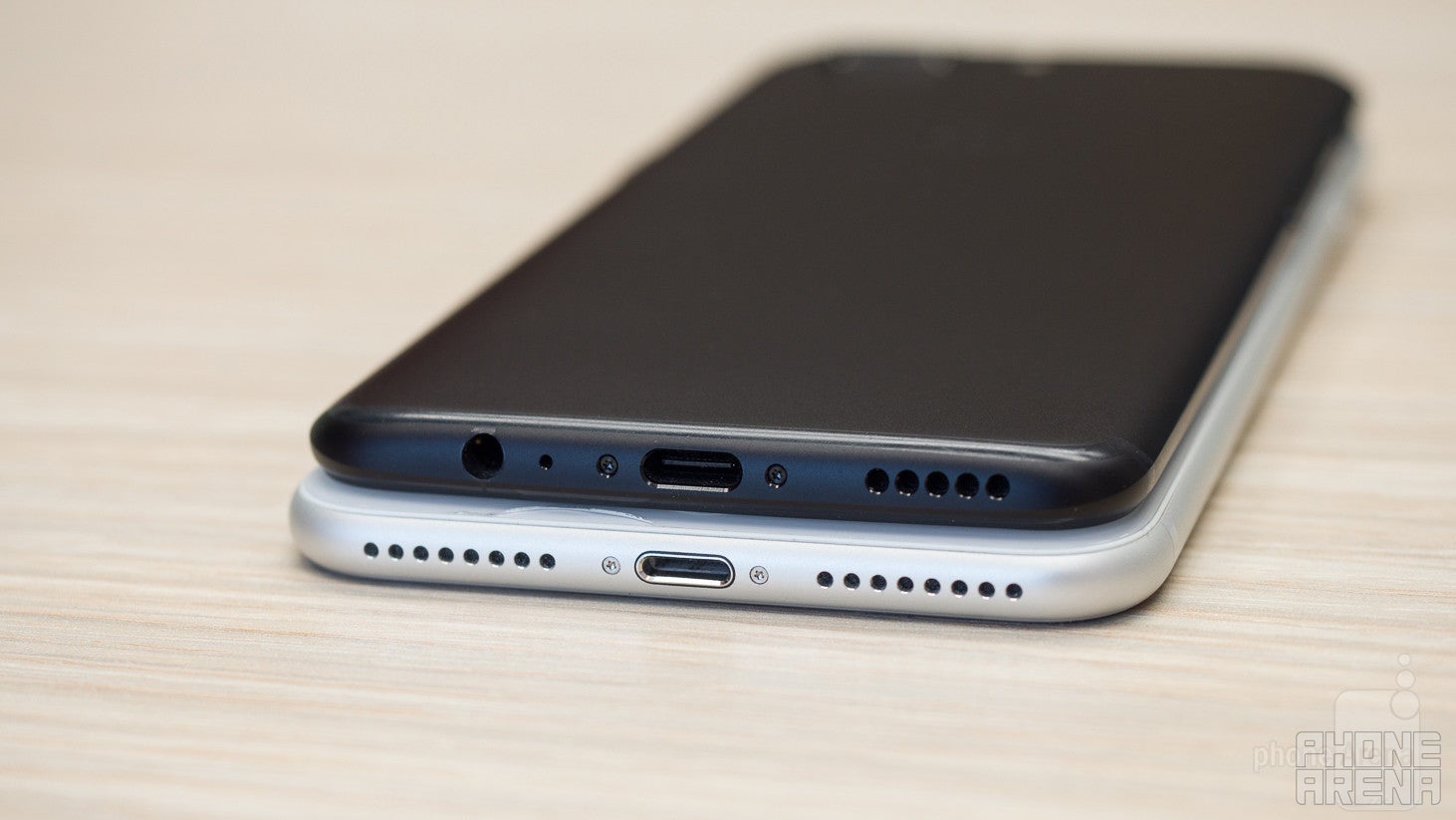
You have a single bottom firing loudspeaker on the OnePlus 5, and it gets very, very loud. It might just be one of the loudest phones we have ever heard and it definitely dwarves the iPhone 7 Plus in terms of how loud it is.
This does not mean that the sound quality is great on the OnePlus 5, though. Just like with most phones, it gets tinny and lacks depth, something even more noticeable and louder volumes, but we appreciate the ability to go extra loud, if only for those times when you want to share a YouTube video with some friends in a slightly louder venue. The iPhone has very good audio quality, but it’s not as loud. It has a dual speaker system, with one speaker at the bottom and another one at the earpiece.
Then, there is the audio jack situation. The iPhone does not have an audio jack, the OnePlus has it. We appreciate Apple’s efforts to bring us into a wireless future, but in the present, the lack of an audio jack is still a downside. Not a dealbreaker, nor something that most people will notice on a daily basis, but definitely something annoying for those times when you want to plug in your phone to a speaker via AUX, or listen to music on a pair of wired headphones.
The rest of the media experience is similar on both: you have a default basic gallery app on the OnePlus, and you also have Google Photos with its excellent cloud backups, while on the iPhone you default to the Photos app that supports iCloud.
Call Quality
We have had no issues with call quality on both phones, so you should not worry about not being able to hear your caller in that one important phone call from your boss or from that company that wants to hire you.
Yet still, we find the iPhone is the one to have cleaner audio, with less distortion and it’s better able to filter out side noises.
Battery life
Two solid battery life performers that will get you through even those busiest days. Not quite 2-day battery life, though.
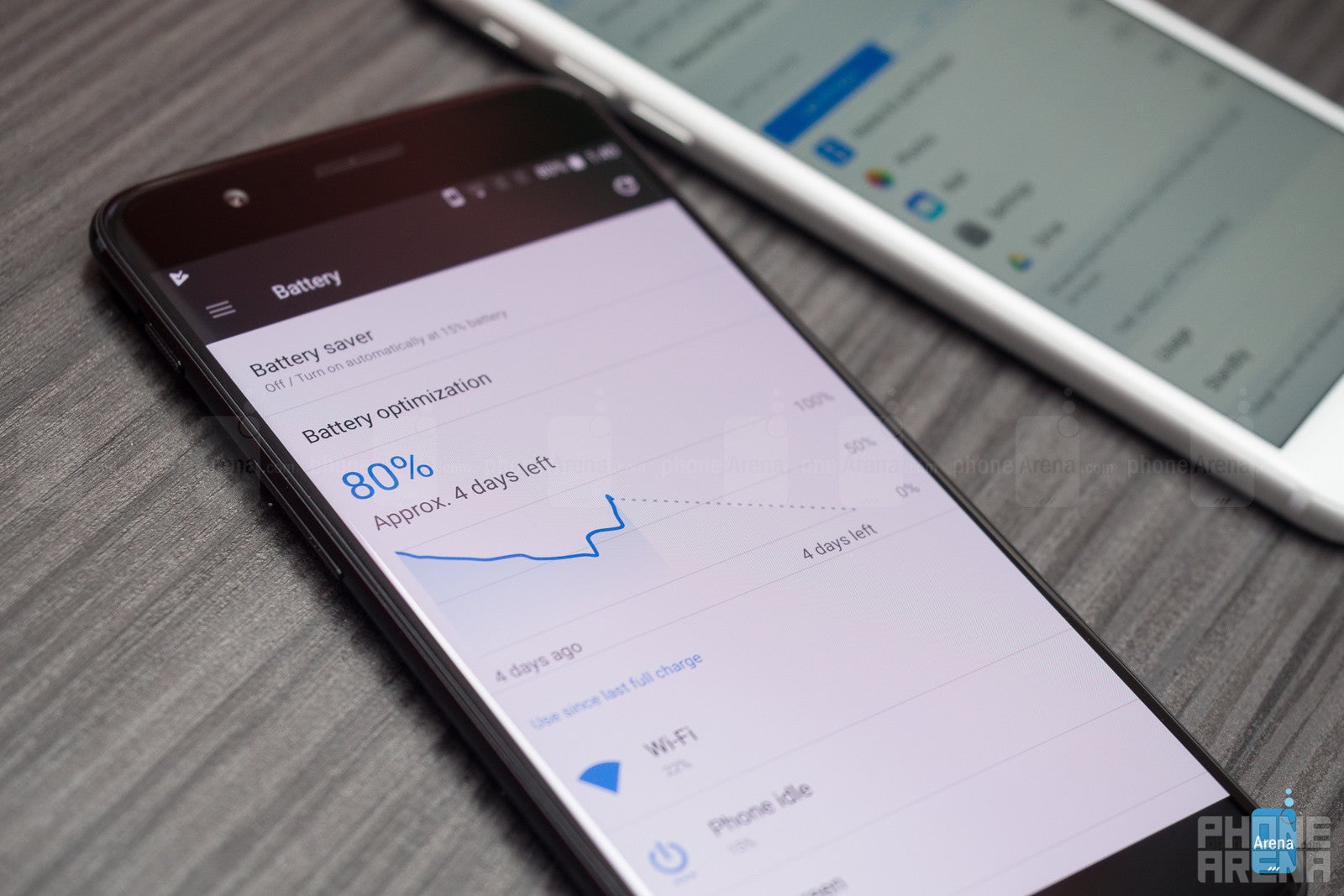
The OnePlus 5 features a 3,300mAh battery, while the iPhone 7 Plus rocks a 2,900mAh battery cell.
We’ve been using both phones for quite a while now, and we can safely say that both are among the better battery performers. We get a full day even with more intense use, but can you get to two days? We found that neither phone is exactly in two-day battery life territory, but the iPhone is a bit closer thanks to its great optimizations and stand-by performance. We’d say that with average use, you would be able to get around a day and a half of both these phones.
To ensure we understand battery life completely, we also ran our custom battery test on the OnePlus 5 and the iPhone 7 Plus. Both scored at the top of the ranks: more than 9 hours, with only a few minutes of difference between the two.
There is one more aspect of the battery situation for any phone: charging speeds. The iPhone 7 Plus still lacks quick charging and it takes an excruciatingly long time to recharge it. This does not matter much in the usual routine where you charge your phone at night, but when you are travelling and you need a quick battery top-up, the iPhone disappoints with slow charging speeds.
The OnePlus 5, on the other hand, excels with its Dash Charge. It’s able to recharge the phone’s battery in nearly half the time that the iPhone needs, and it also quick charges the phone even when you charge while using the phone.
Conclusion
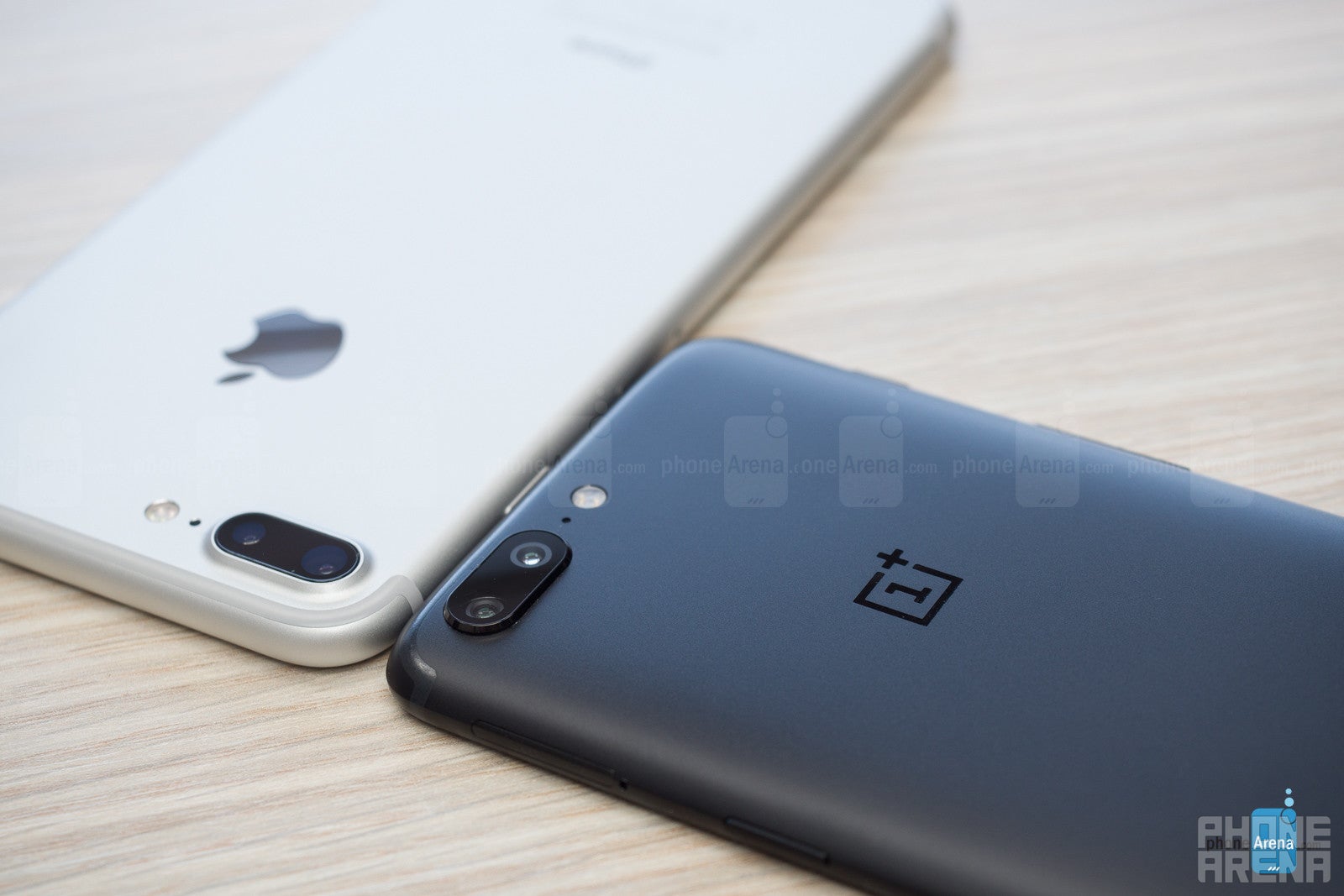
There is one thing that draws a clear line between the OnePlus 5 and the iPhone 7 Plus, and it’s not the performance, features, battery or software: it’s price.
Here is how prices break-down for these two phones:
OnePlus 5 64GB / 128GB: $480 / $540
Apple iPhone 7 Plus 32GB / 128GB / 256GB: $770 / $870 / $970
That’s one considerable difference. Is it worth it?
Here is the grand total: the OnePlus 5 feels well designed, it is fast, has a clean and bloat-free interface, and while it’s camera is not great, it’s still very good. And it rocks great battery life. Should you buy any of these phones for their signature tricks, Portrait mode and dual camera in particular? We don’t think so: the effect is nice to have and you can get some cool shots with it, but it in many ways still feels like a beta product in terms of quality and even ease of use.
However, if you have (and are willing to spend) the money, it feels like the iPhone 7 Plus is the slightly better phone: more fluid in daily use, with the more powerful chip, better quality apps and games, with a slightly better-looking screen and with its guarantee to get updates.
OnePlus 5
Pros
- Affordable for what it is
- Fast (but not so smooth) performance
- Customizable, bloat-free Android interface
- No microSD cards, but has 128 GB option
- (Only) Good camera
- Very good battery life
Apple iPhone 7 Plus
Pros
- Buttery smooth performance
- Great battery life
- Excellent iOS ecosystem
- Guaranteed timely updates
- Gorgeous display
- Very good camera
- Water-proof

Follow us on Google News


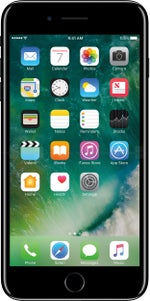





















Things that are NOT allowed:
To help keep our community safe and free from spam, we apply temporary limits to newly created accounts: